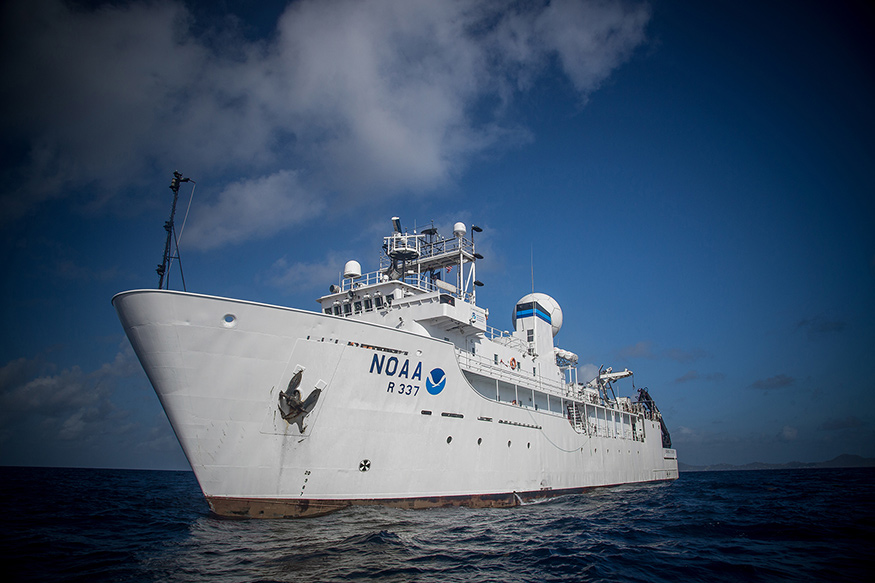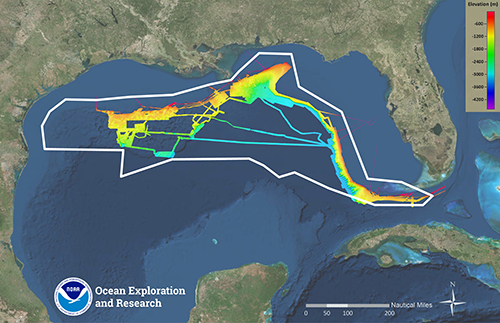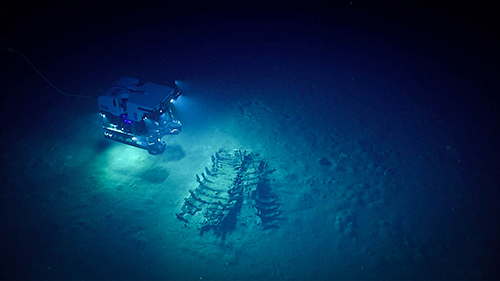Mississippi State’s Northern Gulf Institute supports NOAA Okeanos Explorer, ‘America’s Ship for Exploration’
Contact: Diane Godwin

STARKVILLE, Miss.—A team of Mississippi State researchers is exploring the world’s least known frontier aboard a vessel that’s aiding in their quest for discovery and could help to find new marine species or geologic features.
National Oceanic and Atmospheric Administration scientists report that oceans remain 95 percent “unexplored, unknown and unseen by human eyes,” and NOAA’s Office of Ocean Exploration and Research has operated the ship Okeanos Explorer over the last decade to study the ocean depths with a mission of advancing scientific knowledge. MSU scientists have collaborated in this effort, sharing expertise through the university’s Northern Gulf Institute and helping collect critical baseline information about little known deep-water areas of the Gulf of Mexico.
Conducting high impact research and education programs in the Gulf region, the MSU institute is a NOAA Cooperative Institute and a partnership of six complementary academic institutions, all involved in national strategic research with similar education goals. MSU leads this collaboration that includes the University of Southern Mississippi, Louisiana State University, Florida State University, Alabama’s Dauphin Island Sea Lab, the University of Alabama in Huntsville, and NOAA scientists at various regional laboratories and operational centers.

This spring, NGI researchers worked with NOAA on an Okeanos Explorer voyage to examine new frontiers within deep coral and sponge communities, bottom fish habitats, undersea canyons, shipwrecks, and a variety of chemosynthetic habitats including cold seeps, mud volcanoes and brine pools. Using the ship’s unique capabilities, scientists and audiences onshore viewed the expedition live via real-time video footage from deep-water areas—up to 3,010 meters—of the Gulf of Mexico.
The ship transmitted live images and scientific data over satellite and high-speed internet to scientists observing at various land-based NOAA exploration command centers throughout the country. Over the course of a recent spring expedition, Okeanos Explorer’s team involved scientists, managers and students in the U.S., as well as Canada, Japan, Norway, Russia and the United Kingdom through telepresence technology.
Adam Skarke, an MSU assistant professor of geosciences and NGI researcher, served as the ship’s co-lead scientist. On prior expeditions, the marine geologist served as a NOAA scientist and used sonar systems and robotic submarines to investigate seafloor methane seeps that he helped discover. In the role as co-lead scientist on this expedition, Skarke facilitated scientific discussions utilizing telepresence to include exploration command centers around the country, including the John C. Stennis Space Center in Hancock County. As the expedition was streamed live over the internet to scientists and the public, Skarke’s voice was often heard during the live video feed.
“I was in this public role on a day-to-day basis. As the participating scientists were sharing their high-level expertise on what we were observing in the deep sea, there were numerous members of the general public, including students, watching from aquariums and schools and following along. I tried to explain our exploration work and clarify technical terminology in a way that was easy to understand,” Skarke said.
“In managing the scientific aspects of the expedition, the other co-lead scientist and I were representing the research interests of hundreds of participating scientists, and synthesizing all of their requests into one exploration plan,” he explained.
“One of the most exciting and rewarding things about an Okeanos Explorer expedition is that you are continually exploring locations in the ocean that no one has ever seen before. Because of this, there is always a possibility that you may see a new species of animal or previously undiscovered seafloor feature, and very often you do,” Skarke said.

MSU’s Susan Gottfried, an NGI senior research engineer who works with NOAA’s National Centers for Environmental Information as one of the data team leaders, described how the team supported two successful cruises that produced more than 11 terabytes of data.
“We have been involved with the Okeanos Explorer from when it was first acquired by NOAA from the U.S. Navy and was being re-fit for ocean exploration,” Gottfried said.
“Exploration increases the breadth of knowledge, and research increases the depth of knowledge. The Okeanos Explorer is an exploration vessel that will hopefully catalyze further research. Our team is responsible for managing the data collected and seeing that it is made available to a wide audience.”
During the cruise in late March and early April, the Okeanos Explorer conducted its first emerging technology demonstration projects with partners including the Naval Undersea Warfare Center; Cooperative Institute for Ocean Exploration, Research and Technology; and the Center for Coastal and Ocean Mapping at the University of New Hampshire. Megan Cromwell, MSU research project manager, supported the Okeanos Explorer Gulf of Mexico Technology Demonstration as the onboard data team management leader.
Cromwell said the team performed operational tests to ensure data could be collected at a high quality and transmitted to shore successfully from the ship, as well as from the remotely operated vehicle, Deep Discoverer, and from other digital instruments.
MSU’s Matt Dornback, an NGI research associate, organized a group of scientists to annotate videos of the dives with biological and geological observations. During a few of the expedition dives, MSU’s Kate Rose, an NGI senior research associate and NCEI habitat specialist, annotated with keywords identifying geological features in real time from the Stennis Space Center, while biologists at the NOAA Deep Coral Ecology Lab in Charleston, South Carolina identified and annotated the biological species.
“Every 60 seconds a still image generated from the video feed would pop up, and we had to identify and tag that still image. It is a challenge when a new species shows up,” Rose said.
MSU’s Lauren Jackson, an NGI research associate, was the sample data manager onboard the Okeanos Explorer. Working in the ship’s wet lab, she collected the physical specimens off the ROV and made sure they were properly imaged, labeled, categorized and cataloged. The ship was exploring the Gulf of Mexico with a focus on unmapped areas, deep-sea coral and chemosynthetic communities, when they discovered a sea star, which experts think is likely a new species.
“Working on the Okeanos is pretty much my dream job; it is one of those life goals that was on my bucket list. I feel really fortunate because it is a very amazing thing to be a part of pure exploration,” Jackson said.
Mississippi State’s NGI and NOAA’s Office of Ocean Exploration and Research are planning to work together along with NOAA’s National Centers for Environmental Information to share resources and scientific knowledge on future Okeanos Explorer expeditions in the Gulf. To learn more, visit https://www.ncei.noaa.gov/news/supporting-ocean-exploration-and-data-collection. The Northern Gulf Institute at Mississippi State University is online at http://www.ngi.msstate.edu/.
MSU is Mississippi’s leading university, available online at www.msstate.edu.